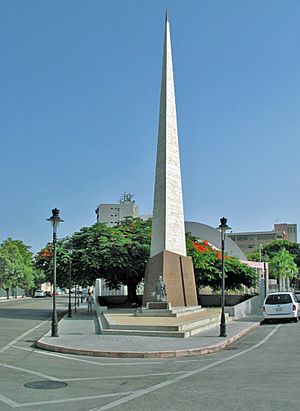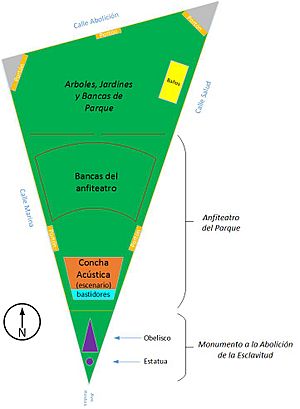Monumento a la abolición de la esclavitud facts for kids
The Monument to the Abolition of Slavery (Monumento a la abolición de la esclavitud) is a special monument in Ponce, Puerto Rico. It's found in Parque de la Abolición in the Cuarto neighborhood. This monument remembers the end of slavery in Puerto Rico in 1873. It's the only monument in the entire Caribbean region built to honor this important event. The monument has two main parts: a tall, pointed stone pillar called an obelisk and a statue known as El Hombre Redimido (The Redeemed Man).

The obelisk monument with the statue at its base
|
|
| Coordinates | 18°00′20.6274″N 66°36′45.9354″W / 18.005729833°N 66.612759833°W |
|---|---|
| Location | Barrio Cuarto, Ponce, Puerto Rico |
| Designer | Statue: Victor Cott Obelisk: City of Ponce |
| Type | Obelisk on Pedestal Statue on Pedestal |
| Material | Marble (obelisk) Iron (statue) |
| Height | 100 feet |
| Beginning date | 1956 |
| Completion date | 1956 |
| Opening date | 1956 |
| Restored date | 2006 |
| Dedicated to | The Abolition of Slavery in Puerto Rico |
Contents
Where to Find the Monument
This important monument is located on Avenida Hostos. It sits where Calle Salud and Calle Marina meet. The monument is the main feature of Parque de la Abolición. You can find it at the very southern tip of the park.
What the Monument Looks Like
The monument has two main parts. One is a tall obelisk, which is a four-sided stone pillar that gets narrower at the top. This obelisk is called Obelisco a la libertad (Obelisk to Freedom). The other part is a statue made of iron. It shows a Black male slave with broken chains. This shows that he is now a free man.
Features of the Monument
The obelisk is 100 feet tall. It stands right behind the black iron sculpture of the freed slave. This statue helps to show the importance of the event.
The Acoustic Shell
Right next to the obelisk, to the north, is an outdoor amphitheater. It is known as La Concha Acústica (The Acoustic Shell). This open-air auditorium is often used for music concerts. The Ponce Municipal Band sometimes performs here.
Why This Monument is Important
Slavery began in Puerto Rico in 1513. People were brought from Africa to work. They replaced the local native people who had been forced into slavery. These new slaves worked on coffee farms, sugar cane fields, and in gold mining. By the 18th century, gold mining was less common. Slaves then mostly worked on coffee and sugar cane plantations. Slavery was officially ended by a royal order on March 22, 1873.
How the Monument Was Built
In 1874, just one year after slavery ended in Puerto Rico, a group of citizens built a small park. They wanted to remember this historic event. In 1880, Olimpio Otero, Juan Mayoral Barnés, and Román Baldorioty de Castro helped create the idea for a larger park. This park would be dedicated to remembering the end of slavery. It is the only memorial of its kind in the Caribbean.
Park Approval and Renovation
Juan Mayoral Barnés presented the idea for the park to the Ponce Municipal Assembly on March 14, 1880. Everyone in the Assembly agreed. The idea was then approved by the Central Government. A Royal Decree confirmed it on March 1, 1881. The park was built in the 1890s. It was renovated in 1956 when Andrés Grillasca Salas was the mayor of Ponce. During this renovation, Concha Acustica de Ponce was built. Also, the statue of the freed slave was added at the base of the obelisk. The artist Victor Cott created this sculpture. The obelisk itself is made of marble and has a metal tip.


